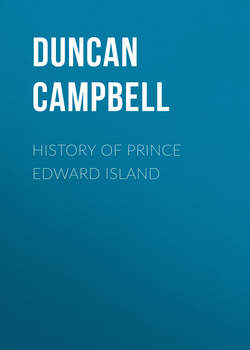History of Prince Edward Island

Реклама. ООО «ЛитРес», ИНН: 7719571260.
Оглавление
Campbell Duncan. History of Prince Edward Island
PREFACE
CHAPTER I
CHAPTER II
CHAPTER III
CHAPTER IV
CHAPTER V
CHAPTER VI
CHAPTER VII
CHAPTER VIII
CHAPTER IX
CHAPTER X
CHAPTER XI
CHAPTER XII
Отрывок из книги
Prince Edward Island is situated in the Gulf of Saint Lawrence. It lies between 46° and 47° 7’ north latitude, and 62° and 64° 27’ longitude west, from Greenwich. As viewed from the north-east, it presents the form of a crescent. Its length, in a course through the centre of the Island, is about one hundred and forty miles, and its breadth, in the widest part, which is from Beacon Point to East Point, towards its eastern extremity, thirty-four miles. It is separated from Nova Scotia by the Strait of Northumberland, which is only nine miles broad between Cape Traverse and Cape Tormentine. From the Island of Cape Breton it is distant twenty-seven miles, and from the nearest point of Newfoundland one hundred and twenty-five miles.
The Island was amongst the first discoveries of the celebrated navigator, Cabot, who named it Saint John, as indicative of the day of its discovery. Britain failing to lay claim to it, the French afterwards assumed it as part of the discoveries made by Verazani in 1523. In 1663 it was granted, with other Islands, by the Company of New France, to the Sieur Doublet, a captain in the French navy, with whom were associated two adventurers who established a few fishing stations, but who did not reside permanently on the island.
.....
In December, 1763, the Earl of Egmont, then first Lord of the Admiralty, presented an elaborate memorial to the King, praying for a grant of the whole Island of Saint John, to hold the same in fee of the Crown forever, according to a tenure described in the said memorial. On the supposition that the island contained two millions of acres, – for it had not then been surveyed, – he proposed that the whole should be divided into fifty parts of equal extent, to be designated Hundreds, as in England, or Baronies, as in Ireland; forty of these to be granted to as many men who should be styled Lords of Hundreds, and each of whom should pay to the Earl, as Lord Paramount, twenty pounds sterling yearly. On the property of the Earl – to whom, with his family of nine children, ten hundreds were to be allotted – a strong castle was to be erected, mounted with ten pieces of cannon, each carrying a ball of four pounds, with a circuit round the castle of three miles every way. The forty Hundreds or Baronies were to be divided into twenty manors of two thousand acres each, which manors were to be entitled to a Court Baron, according to the Common Law of England. The Lord of each Hundred was to set apart five hundred acres for the site of a township, which township was to be divided into one hundred lots, of five acres each, and the happy proprietors of five acres were each to pay a yearly free-farm rent of four shillings sterling to the Lord of the Hundred. Each Hundred was to have a fair four times a year, and a market twice in every week. There were also to be Courts Leet and Courts Baron, under the direction of the Lord Paramount. A foot-note referring to these Courts, attached by the framers of the memorial, indicates the ideas which were entertained at this time in the old country respecting protection to life and property in the North American Colonies. “These courts – established by Alfred and others of our Saxon Princes, to maintain order, and bring justice to every man’s door – are obviously essential for a small people, forming or formed into a small society in the vast, impervious, and dangerous forests of America, intersected with seas, bays, lakes, rivers, marshes, and mountains; without roads, without inns or accommodations, locked up for half the year by snow and intense frost, and where the settler can scarce straggle from his habitation five hundred yards, even in times of peace, without risk of being intercepted, scalped, and murdered.”
To epitomise the proposal: there was to be a Lord Paramount of the whole island, forty Capital Lords of forty Hundreds, four hundred Lords of Manors, and eight hundred Freeholders. For assurance of the said tenures, eight hundred thousand acres were to be set apart for establishments for trade and commerce in the most suitable parts of the island, including one county town, forty market towns, and four hundred villages; each Hundred or Barony was to consist of somewhat less than eight square miles, and the Lord of each was bound to erect and maintain forever a castle or blockhouse as the capital seat of his property, and as a place of retreat and rendezvous for the settlers; and thus, on any alarm of sudden danger, every inhabitant might have a place of security within four miles of his habitation. A cannon fired at one of the castles would be heard at the next, and thus the firing would proceed in regular order from castle to castle, and be the means, adds the noble memorialist, “of putting every inhabitant of the whole island under arms and in motion in the space of one quarter of an hour.”
.....